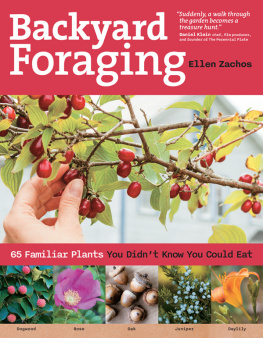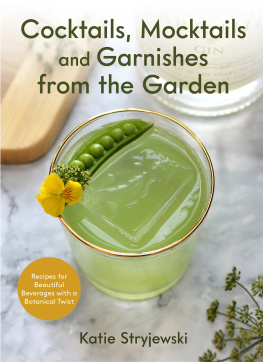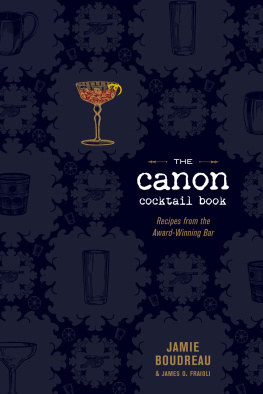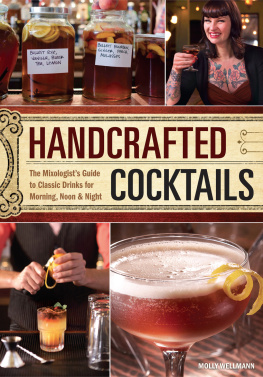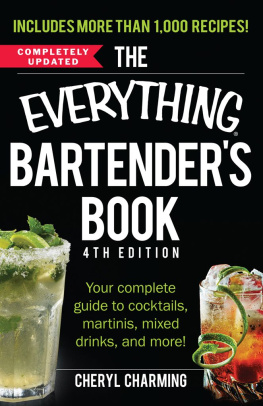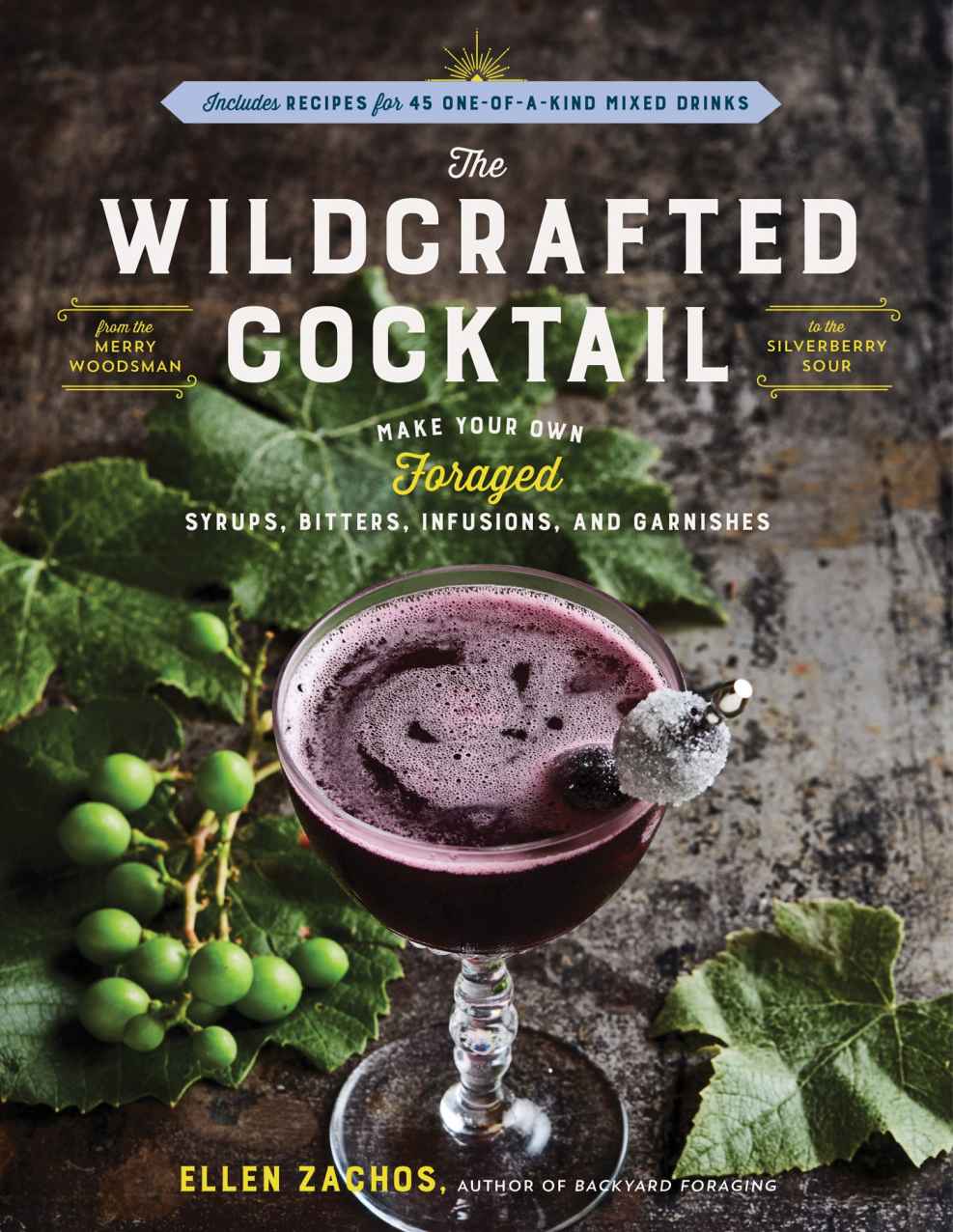
Dedication
I dedicate this book to my father, Kimon Zachos. Dad didnt drink, but he believed in having a fully stocked bar for friends and family to enjoy. I wish he were here so we could toast the publication of this book. Apparently an interest in and appreciation for mixology is something you can inherit. Or at least share. Thanks, Dad.
I have many people to thank for helping me with this book. My loyal team of proofreaders, Michael, John, and Elizabeth, have never failed me. The professional mixologists who contributed recipes were creative and excited to experiment with foraged ingredients. And the sensational Butter Wilde generously gave of her time and extraordinary talents to help me in the kitchen.
Contents
Introduction
Why Foraged Mixology?
Why would anyone want to forage for cocktail ingredients? Its so much easier to go to a liquor store, or a grocery store, or a farmers market. Why would you choose to tromp through the woods, hunt down some edible plants, carry them home, clean them off, and figure out how to use them in a cocktail?
Foraging has its own unique pleasures. Though we no longer need to forage to survive, many of us still find it fascinating and satisfying. Is it the lure of free food? The thrill of the hunt? The promise of unbuyable flavors? For people who appreciate unusual tastes, wild edibles offer exciting ingredients and new opportunities.
If youre already a forager, many of the ingredients in this book will be familiar to you. If youve never foraged before, welcome to the club! Theres a recommended reading list at the back of the book to help you learn more about edible plants in your area. Pick one or two field guides and really get to know your plants. I cant stress enough how important proper plant identification is.
Picking Wild Things
Foraging is only fun when its safe, and its your responsibility (if youre old enough to drink, youre old enough to be responsible) to make intelligent, educated choices about what you choose to eat.
Take a class, join an online wild foods group or local foraging club, read everything you can get your hands on. If you know of a local bar or restaurant that serves wild foods, try some foraged flavors to see if you like them. Some of the ingredients in this book can actually be purchased in stores, online, and in herb shops. If youre curious about whether something is worth the work of hunting and gathering, try buying a bit of it if possible and see what you think. I guarantee that wild foods will taste even better when youve harvested them yourself.
One of the best things about foraging is that you harvest wild edibles at their peak and use them, or preserve them, when theyre at their most delicious. No one picks cornelian cherries before theyre ripe or Japanese knotweed when its passed its tender best. The wild foods youll use in these cocktails have limited seasons when theyre ripe and ready. Youll capture those seasonal flavors and use them to create cocktails that represent a specific moment and place. Its almost magical, and it makes your cocktails unique.
As a forager, I look for delicious wild plants wherever I go, and I try to use as many as possible in my daily life. After hunting for mushrooms, greens, fruits, and nuts, my idea of a good time is a weekend in the kitchen playing with what Ive found. That includes both food and drink. With the craft cocktail movement in full swing, it makes perfect sense to bring foraged ingredients into the bar as well as the kitchen.
Ive made wild wines and meads for years, but my interest in foraged mixology took a big step forward when I was hired by Rmy Cointreau USA to teach a series of foraged mixology workshops across the country for The Botanist gin. I introduced bartenders to the wild plants they could forage in their areas, and together we turned them into unusual cocktails. Id fallen hard for The Botanist a year before meeting anyone from Rmy, which was nice, because I wouldnt endorse a product I didnt think was terrific. Not ever. Thats a promise.
I enjoy a wide range of spirits, and writing this book has been a joy, as Ive tested different distilled flavors and combined them with some of my favorite wild edibles. Its a whole new way to incorporate unbuyable flavors into your daily ritual. Come have a drink with me.
Eating wild plants and fungi is inherently risky. Individual people may make mistaken identifications regardless of their level of expertise or the accuracy of printed information, and they also vary in their physiological reactions. The publisher and the author cannot accept responsibility for readers health. Eat wild foods at your own risk, and always drink responsibly.
Chapter One
Anatomy of a Foraged Cocktail
What is a cocktail? The first mention of a cocktail as an alcoholic beverage dates from 1806, when it was defined as a drink composed of spirits, sugar, water, and bitters. Since then, mixologists and adventurous drinkers have taken this definition and run with it, creating vast and varied categories of alcoholic beverages that include everything from sours, highballs, and spirit-forward cocktails to flips, fixes, rickeys, collinses, juleps, smashes, and tiki drinks.
Dont worry, I promise there isnt a quiz at the end of this section. All you need to know is that each of these categories is defined by the type of ingredients that go into it. For example, a sour is made up of a base spirit, citrus juice, sugar, and (if you like) an egg. A highball is a base spirit, ice, and a usually carbonated mixer. Once you understand the general outline of a cocktail, you can play around with foraged ingredients within the form.
Maybe youll start by simply substituting wild ingredients for more traditional cocktail components. Can you use pickled field garlic in place of a pickled onion in your next Gibson? Or cornelian cherry syrup in place of grenadine in your next Tequila Sunrise? The answer to both questions is yes, of course you can.
The easiest way to start incorporating foraged ingredients into your cocktails is by making some simple substitutions. Youre probably familiar with traditional ingredients like lemon juice, simple syrup, and soda, but can you capture those same flavors with wild ingredients? Absolutely. Here are a few useful foraged substitutes. With these basics in your refrigerator, youre off to a good start.
Next page


